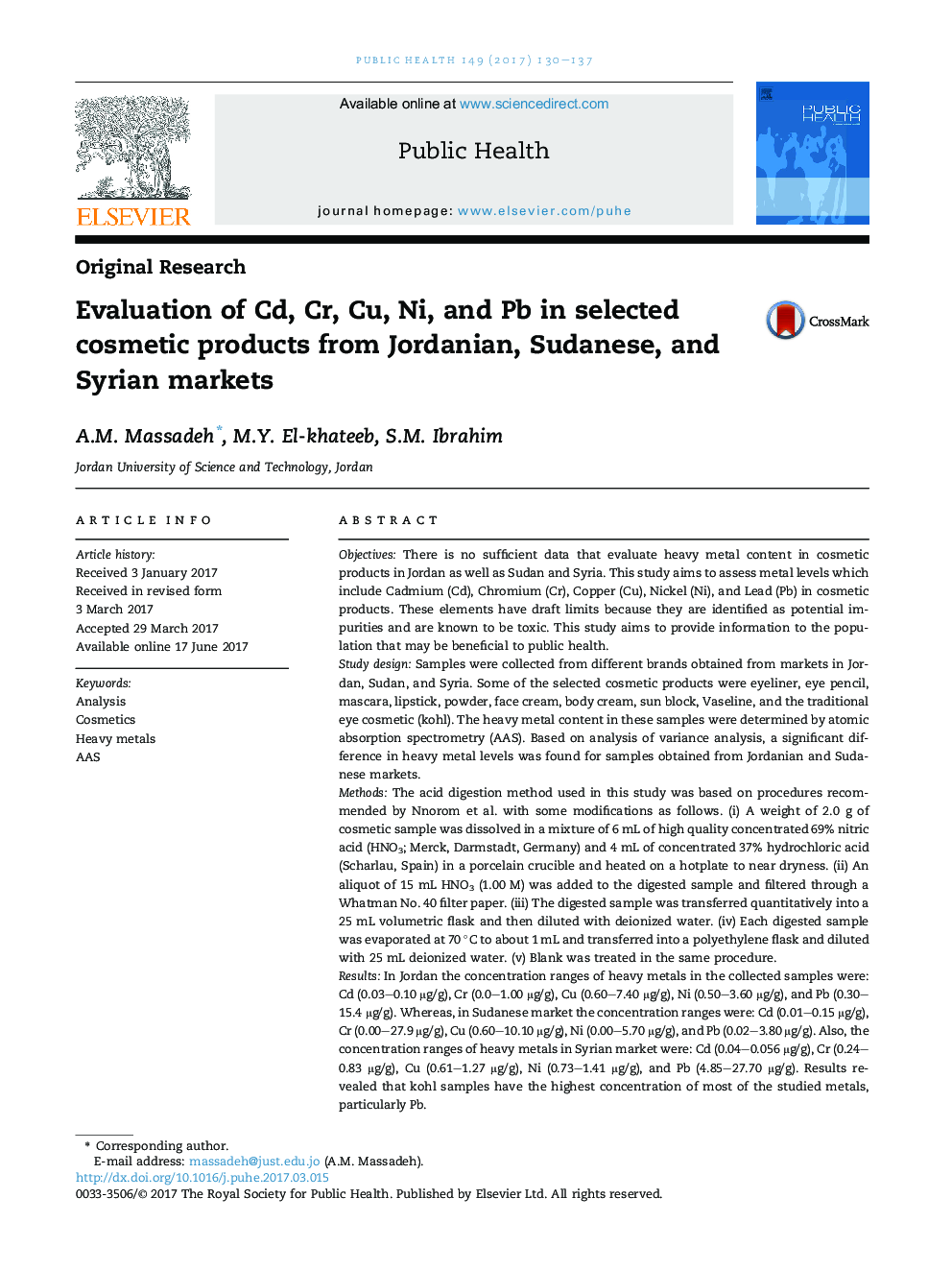| کد مقاله | کد نشریه | سال انتشار | مقاله انگلیسی | نسخه تمام متن |
|---|---|---|---|---|
| 5122877 | 1487194 | 2017 | 8 صفحه PDF | دانلود رایگان |
- Cosmetics are substances used as personal care products to enhance or protect the appearance or odor of the human body.
- Cosmetics may contain harmful levels of toxic substances such as heavy metals.
- This study aims to investigate Cd, Cr, Cu, Ni and Pb in cosmetic samples from Jordan, Sudan and Syria.
- To introduce advices to the population because toxic elements have draft limits as potential impurities in cosmetics.
- Results revealed that kohl samples have high concentration of most of the tested elements, particularly Pb.
ObjectivesThere is no sufficient data that evaluate heavy metal content in cosmetic products in Jordan as well as Sudan and Syria. This study aims to assess metal levels which include Cadmium (Cd), Chromium (Cr), Copper (Cu), Nickel (Ni), and Lead (Pb) in cosmetic products. These elements have draft limits because they are identified as potential impurities and are known to be toxic. This study aims to provide information to the population that may be beneficial to public health.Study designSamples were collected from different brands obtained from markets in Jordan, Sudan, and Syria. Some of the selected cosmetic products were eyeliner, eye pencil, mascara, lipstick, powder, face cream, body cream, sun block, Vaseline, and the traditional eye cosmetic (kohl). The heavy metal content in these samples were determined by atomic absorption spectrometry (AAS). Based on analysis of variance analysis, a significant difference in heavy metal levels was found for samples obtained from Jordanian and Sudanese markets.MethodsThe acid digestion method used in this study was based on procedures recommended by Nnorom et al. with some modifications as follows. (i) A weight of 2.0 g of cosmetic sample was dissolved in a mixture of 6 mL of high quality concentrated 69% nitric acid (HNO3; Merck, Darmstadt, Germany) and 4 mL of concentrated 37% hydrochloric acid (Scharlau, Spain) in a porcelain crucible and heated on a hotplate to near dryness. (ii) An aliquot of 15 mL HNO3 (1.00 M) was added to the digested sample and filtered through a Whatman No. 40 filter paper. (iii) The digested sample was transferred quantitatively into a 25 mL volumetric flask and then diluted with deionized water. (iv) Each digested sample was evaporated at 70 °C to about 1 mL and transferred into a polyethylene flask and diluted with 25 mL deionized water. (v) Blank was treated in the same procedure.ResultsIn Jordan the concentration ranges of heavy metals in the collected samples were: Cd (0.03-0.10 μg/g), Cr (0.0-1.00 μg/g), Cu (0.60-7.40 μg/g), Ni (0.50-3.60 μg/g), and Pb (0.30-15.4 μg/g). Whereas, in Sudanese market the concentration ranges were: Cd (0.01-0.15 μg/g), Cr (0.00-27.9 μg/g), Cu (0.60-10.10 μg/g), Ni (0.00-5.70 μg/g), and Pb (0.02-3.80 μg/g). Also, the concentration ranges of heavy metals in Syrian market were: Cd (0.04-0.056 μg/g), Cr (0.24-0.83 μg/g), Cu (0.61-1.27 μg/g), Ni (0.73-1.41 μg/g), and Pb (4.85-27.70 μg/g). Results revealed that kohl samples have the highest concentration of most of the studied metals, particularly Pb.ConclusionsBased on the results obtained, it is likely to conclude the following: (i) It is not possible to completely eliminate the presence of heavy metals from cosmetic products after manufacturing. However, the quality of the products can be improved by careful selection of raw materials, taking in consideration heavy metal levels. (ii) Heavy metal concentration in lipstick differs with different manufacturers' colors and shade. Statistically significant associations between Pb level and the cosmetic type were found. (iii) Heavy metals levels including Cd, Cr, Cu, Ni, and Pb may impose risk in daily use and repeated application as well as in ingestion through the mouth even at concentration below the allowed limits. (iv) It is the manufacturers' responsibility to ensure that the finished cosmetic product contains the lowest levels possible of heavy metals. So it does not exceed the limits set by health authorities.
Journal: Public Health - Volume 149, August 2017, Pages 130-137
